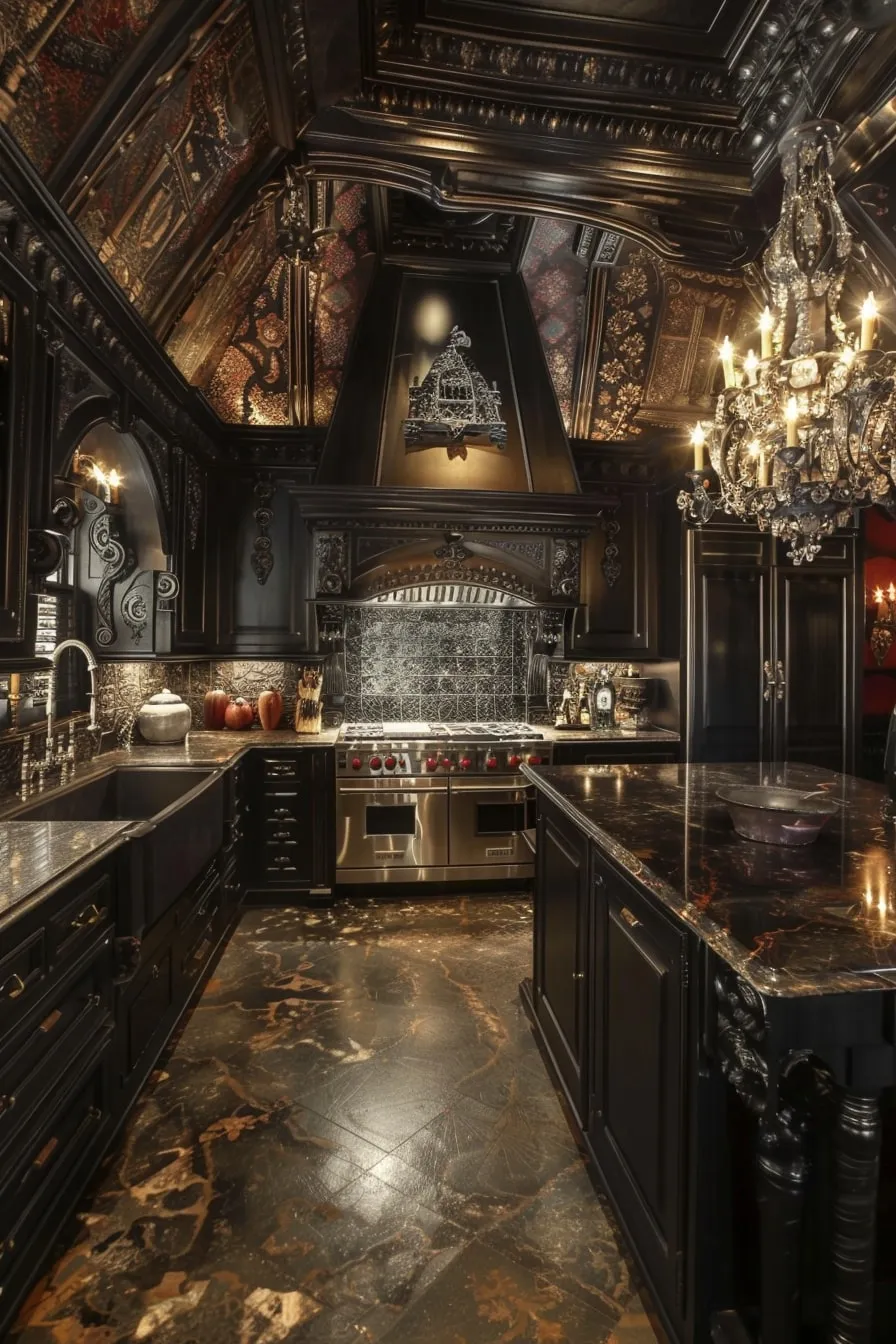Embracing the Gothic Kitchen Decor
Gothic kitchen decor is an enchanting way to infuse your home with a sense of mystery, elegance, and drama. This design style, inspired by the architecture and aesthetics of the Gothic period, focuses on rich colors, intricate details, and a touch of the macabre. Creating a gothic kitchen isn’t about making your space dark and uninviting; it’s about crafting a space that is both visually stunning and deeply personal. The key is to balance the darkness with elements of luxury and sophistication, ensuring your kitchen becomes a captivating sanctuary. It’s a journey of self-expression, where you can showcase your unique personality and love for the extraordinary. With the right approach, your gothic kitchen will be a space where you can cook, dine, and entertain in a truly unforgettable atmosphere. Explore the unique details and embrace the shadows to create a space that you will adore.
Dark Color Palettes in Gothic Kitchens
The foundation of any gothic kitchen is its color palette. Deep, rich, and dramatic colors are essential for setting the mood. Think beyond the usual bright and airy kitchen and embrace the darker side, where hues like black, charcoal gray, deep burgundy, and forest green reign supreme. These colors create a sense of depth and sophistication, while also providing a perfect backdrop for the other design elements. While these darker shades may seem intimidating, they can transform your kitchen into a cozy, inviting space. The use of such colors brings a unique atmosphere and is an excellent choice if you want to design a unique space. Furthermore, consider the lighting to ensure the colors appear as intended. Consider the color of your cabinets, countertops, and walls to make the space cohesive, sophisticated, and attractive.
Deep and Dramatic Hues
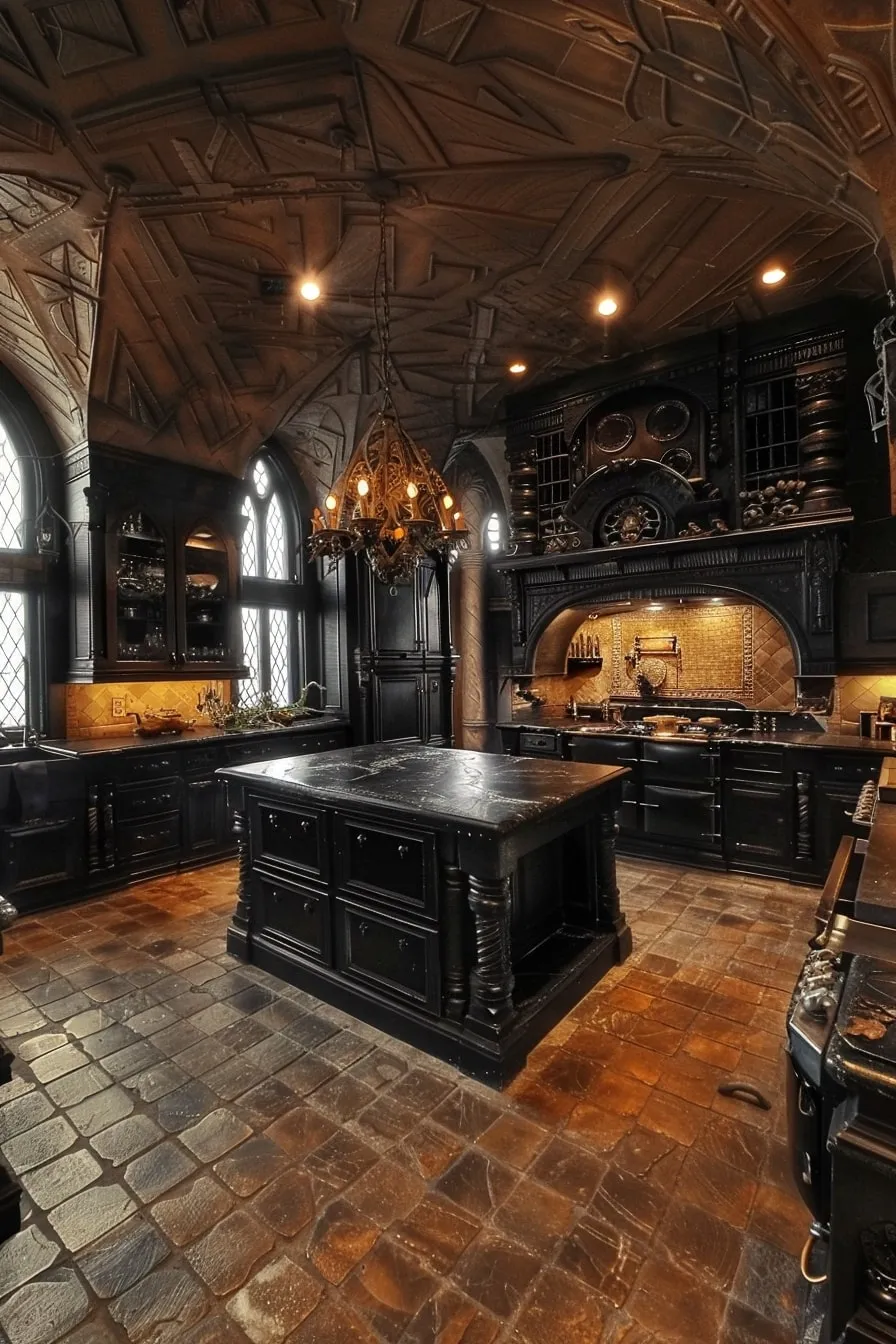
Within the realm of dark colors, specific hues stand out as particularly effective. Black is a timeless choice, offering an unmatched level of sophistication and drama. Charcoal gray provides a softer, yet equally impactful alternative, while deep burgundy and forest green add warmth and richness. Incorporate these colors strategically. For example, paint your cabinets black or charcoal gray, use burgundy for an accent wall, or introduce forest green through your kitchen accessories. When choosing your colors, consider the size of your kitchen. Lighter shades within the gothic palette, such as deep creams or muted grays, can help prevent the space from feeling too enclosed. No matter which shades you select, focus on creating a balanced and visually engaging space. The goal is to create an immersive atmosphere that exudes elegance and intrigue.
Accent Walls and Statement Pieces
Accent walls and statement pieces are vital in a gothic kitchen as they add depth, visual interest, and a touch of personalization. An accent wall can be painted in a darker shade than the rest of the kitchen, or it can feature a textured finish like exposed brick or faux stone, introducing an element of visual contrast. Consider adding dramatic artwork, such as a large oil painting with a dark theme, or a striking mirror with an ornate frame. These elements can be carefully chosen to reflect your personality and enhance the overall aesthetic of your gothic kitchen. Statement pieces like a unique chandelier, a vintage kitchen island, or even an antique dining table can serve as focal points, anchoring the space and drawing the eye. Make certain these elements enhance the overall theme, create focal points, and enhance visual appeal.
Incorporating Gothic Furniture
The furniture in your gothic kitchen is key to achieving the desired look and feel. Look for pieces with strong lines, intricate carvings, and dark finishes. Think about selecting a kitchen island with ornate legs, a dining table with a weathered wood top, or chairs with high backs and upholstered seats. Antique furniture is perfect for a gothic kitchen. These pieces bring an authentic touch of history and character. Look for furniture made from dark woods like mahogany or walnut. Consider the style of your furniture. You could go for gothic revival, which features architectural elements and pointed arches, or the more ornate baroque style. Keep in mind that your furniture should not only be visually appealing but also functional. Select pieces that are practical for your daily needs while still adhering to the gothic aesthetic.
Ornate Cabinets and Dark Wood
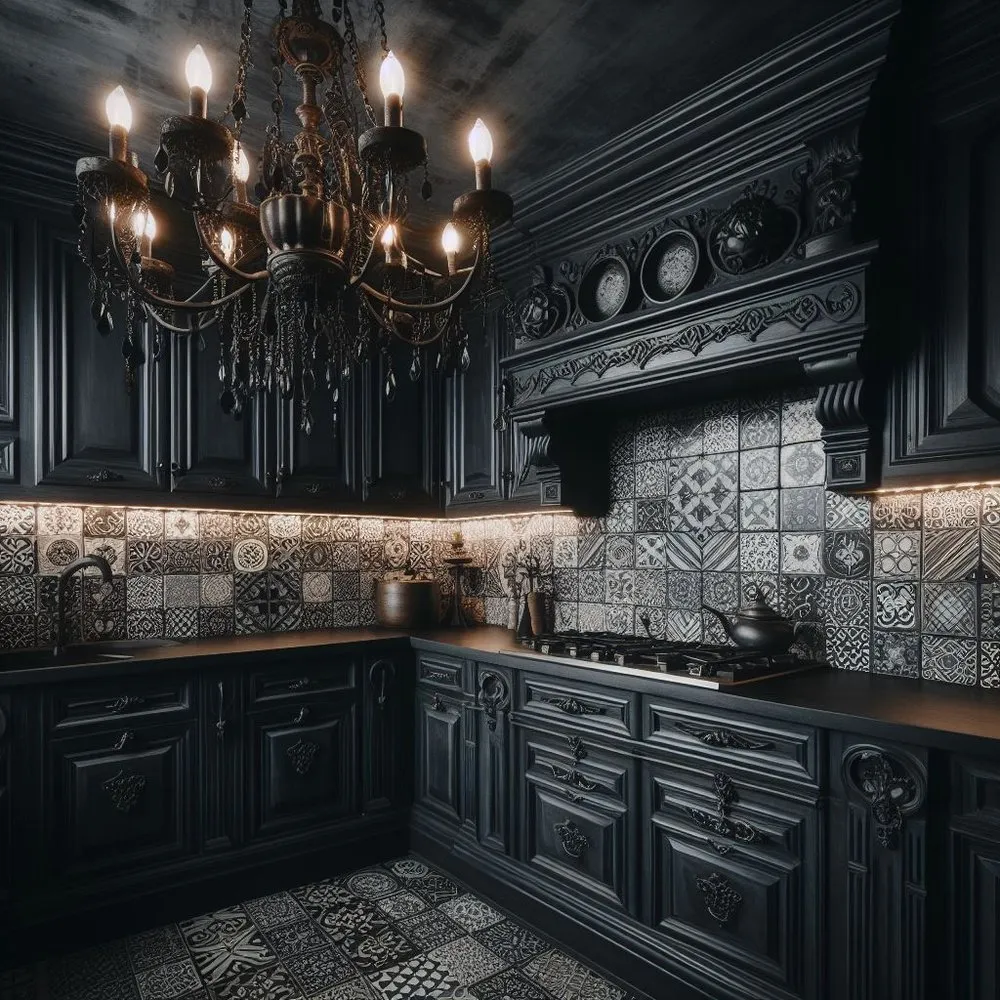
Cabinets are a key element, and their design can significantly impact the kitchen’s atmosphere. Choose cabinets with intricate details, such as raised panels, elaborate moldings, or even hand-carved designs. Dark wood finishes are ideal. Consider rich shades like ebony, dark walnut, or even a deep, stained finish that brings out the wood’s natural grain. If you prefer a painted finish, opt for matte black or a deep, saturated color. Handles and knobs also play a role in enhancing the gothic theme. Select hardware made from wrought iron, antique brass, or even pewter. These materials bring a sense of history and elegance. You can also incorporate elements like gothic arches into the cabinet design, which can enhance the visual appeal of your kitchen.
Vintage and Antique Finds
Incorporating vintage and antique pieces is a fantastic way to add character and authenticity to your gothic kitchen. Hunt for unique finds at antique shops, flea markets, and online auctions. An antique buffet can be used as a kitchen storage unit. A vintage dining table or a set of antique chairs will provide seating with a gothic flair. Consider the finish and details of each piece. Look for items with intricate carvings, dark finishes, and a sense of history. Don’t be afraid to mix and match different styles and periods. The goal is to create a collected, layered look that feels personal and curated. Furthermore, the charm of these pieces will add to the unique ambiance of the kitchen.
Adding Gothic Lighting Fixtures
Lighting plays a crucial role in creating a gothic ambiance. It’s more than just illuminating a space; it’s about setting a mood. The right lighting fixtures can highlight architectural details, cast dramatic shadows, and enhance the overall aesthetic. Consider the interplay of light and shadow. Gothic kitchens benefit from layered lighting, incorporating a combination of ambient, task, and accent lighting to create depth and visual interest. Embrace the power of dimmers. They allow you to adjust the intensity of the light to suit the time of day or the occasion, adding to the overall atmosphere of the kitchen. Consider the lighting style to enhance the space.
Chandeliers and Sconces
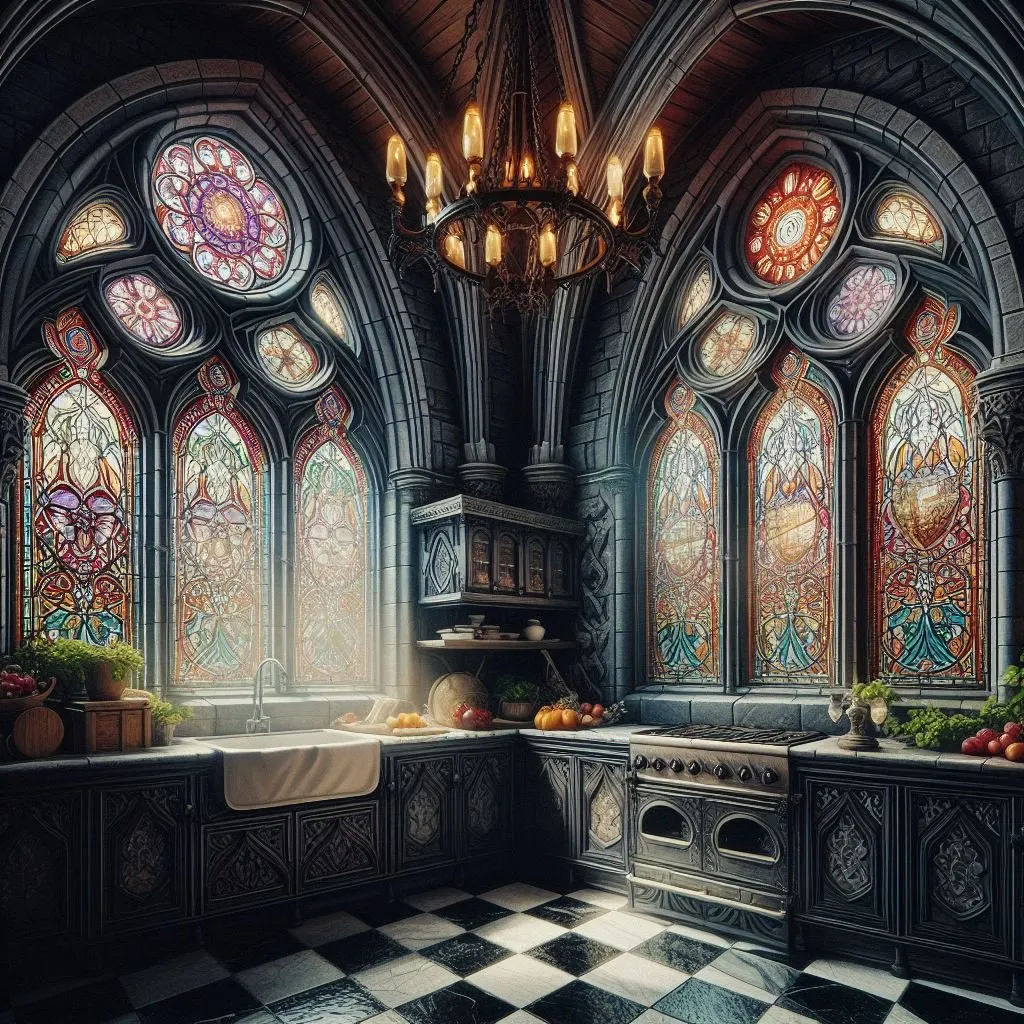
Chandeliers are a staple in gothic decor. They can be the focal point of your kitchen. Opt for chandeliers made of wrought iron, crystal, or even a combination of materials. The design should be ornate, with intricate details and a dark finish. Place your chandelier over the kitchen island or dining table to create a stunning focal point. Sconces can be mounted on the walls to provide ambient lighting. Select sconces with a gothic flair, such as those with candle-like bulbs or those made from wrought iron. The use of dimmable bulbs will give you control over the intensity of the light, allowing you to adjust the mood to suit your needs. Consider these items as focal points to bring the kitchen together.
Using Gothic-Inspired Accessories
Accessories are the finishing touches that bring your gothic kitchen to life. These elements add personality, history, and visual interest. When choosing accessories, think about items that complement your color scheme and furniture. Look for items that add a touch of gothic charm. This includes unique pieces that will make your space visually appealing and captivating. From practical kitchen tools to decorative items, every element is carefully chosen to enhance the gothic theme. These will bring a sense of cohesion to the space.
Candles and Gothic Decor
Candles are a key accessory in gothic kitchens. They add a touch of romance and drama. Use candles in various sizes and styles. Tapered candles in ornate holders, pillar candles in different heights, and even battery-operated candles can create a warm and inviting ambiance. Gothic decor also includes elements like antique clocks, ornate mirrors, and vintage serving pieces. Display these items strategically to create visual interest. Consider adding vintage or antique cookbooks to your display. Place them on open shelves or countertops to add a touch of history and personality. Don’t be afraid to get creative with your accessories. They are an opportunity to express your unique personality and enhance your kitchen’s gothic charm.
Textiles and Fabrics to Enhance the Style
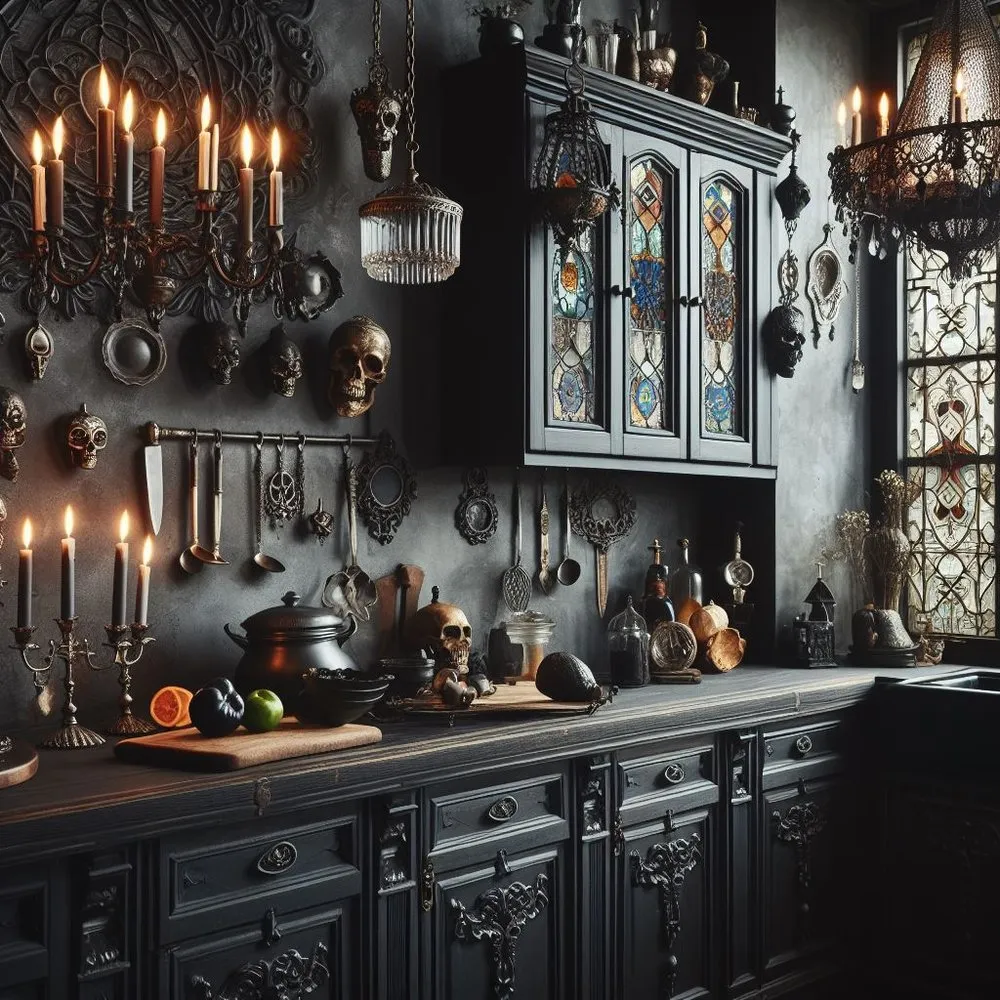
Textiles and fabrics can transform the look and feel of your gothic kitchen. Use them strategically to add texture, warmth, and visual interest. Select fabrics that complement your color scheme and furniture. Consider rich fabrics like velvet, damask, and brocade. These materials add a touch of luxury and sophistication. Use these fabrics for your window treatments, tablecloths, or even upholstery. Use dramatic curtains to create a gothic feel. The use of these can bring the room together, and give it a more curated look. Also, consider patterned textiles with gothic motifs, such as fleur-de-lis or gothic architecture. These elements will contribute to the theme and enhance the overall aesthetic.
Velvet and Damask
Velvet and damask are two of the most luxurious fabrics perfect for a gothic kitchen. Velvet adds a touch of opulence and softness. Use velvet curtains or upholstered chairs to create a sense of luxury. Damask, with its intricate patterns and rich texture, is perfect for adding elegance and sophistication. Use damask tablecloths, runners, or upholstery to enhance your gothic kitchen. When choosing your fabrics, consider the colors, patterns, and textures. These will complement your furniture, accessories, and overall design scheme. The goal is to create a cohesive and visually stunning space. The use of these luxurious fabrics can transform your kitchen.
Conclusion for Gothic Kitchen Decor
Creating a gothic kitchen is a rewarding project that allows you to express your unique style and appreciation for history and drama. By incorporating elements like dark color palettes, ornate furniture, dramatic lighting, and gothic-inspired accessories, you can transform your kitchen into a space that is both beautiful and functional. Remember to balance the darkness with elements of luxury and sophistication. This ensures the space feels inviting. Have fun with the process, explore different ideas, and don’t be afraid to experiment with your creativity. Your gothic kitchen will be a reflection of your personality and passion, offering a captivating space to enjoy cooking, dining, and entertaining for many years to come. Embrace the shadows, and design the kitchen of your dreams. Now, go ahead and add your personal touch to the space!
